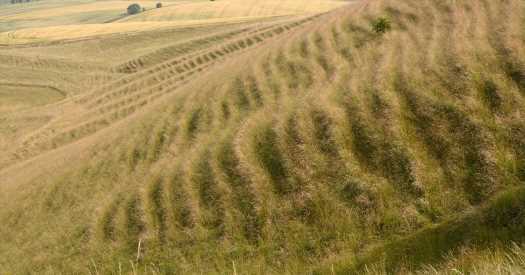
Mountains look solid. But that just might be a mirage. On extremely long time scales, natural landscapes are creeping and flowing like viscous streams.
Until recently, most scientists would have said that things like burrowing animals, falling trees, earthquakes and lightning strikes were responsible for deforming much of the world’s terrain. But new experiments that involve shooting ultraprecision laser beams at sand piles instead suggest that creep is an inherent part of any environment and would occur even in the absence of all other action.
“Everything is moving all the time,” said Nakul Deshpande, a geophysics doctoral candidate at the University of Pennsylvania. “It’s not just an analogy. It’s real, it’s what’s happening.”
Mr. Deshpande, who studies the science of scenery, has recently taken a careful look at creep (the geological process, not the Radiohead song.) Researchers have long known that loose, weathered soil persistently moves, slumping and changing at a rate of centimeters per year.
But getting good data on creep has always been difficult. Markers buried in hillsides will become displaced over the course of decades, yet isolating the exact causes of such changes is nearly impossible.
In the lab, Mr. Desphande and his colleagues placed large pyramidal piles of sand on a vibration-dampening table, shut off all the lights and kept the temperature and humidity constant. They shined a laser on the heap in such a way that the light rays would bounce around and interfere with one another, creating a speckled pattern on a detector.
By looking for slight changes in the pattern, they could observe delicate movements of the sand grains at scales of millionths of a meter. Materials like sand have what is called a natural angle of repose — if the sides of a pile become steeper than a certain angle, its grains will sweep downward in miniature landslides.
Mr. Deshpande and his colleagues set up their sand pyramids to be below the angle of repose, meaning that theoretically they should have just sat there. Yet their laser speckles showed that nearly two weeks after the pile was poured, the sand grains were still moving ever so slightly, at a rate equivalent to centimeters per year, more or less exactly what is observed with creep in the field. Their findings appeared Wednesday in the journal Nature Communications.
The results were surprising, even to members of the team. “Though I thought it might happen, it’s still creepy,” said Douglas Jerolmack, a geophysicist and Mr. Deshpande’s adviser.
Yet a lab is not completely disconnected from its environment and the researchers couldn’t be certain that an overhead airplane hadn’t somehow disturbed their experiment. To confirm their hunches, they also conducted simulations in a computer with virtual sand grains subject to nothing but the forces of gravity and friction and saw the same infinitesimal movements as with the real-world pile.
To further study what influences creep, the team introduced small changes to their sand mounds. For instance, they heated the heaps, which thermally expanded the grains and increased the rate at which they slid around.
Nathalie Vriend, a geophysicist at the University of Cambridge who was not involved in the new study, had been skeptical that creep might happen in the absence of external disturbances. But after conducting some of her own experiments and hearing Mr. Deshpande present his results at a conference in March, she has come around to the idea.
“I remember listening and saying, ‘This is really cool work,’” she said. “As an experimentalist, I appreciate when people find new techniques to measure something that was previously hidden.”
While agreeing that the experimental results are interesting and novel, Anne Voigtländer, a geomorphologist at the GFZ German Research Centre for Geosciences, wasn’t entirely sure they could yet be executed outside the controlled lab environment. “I don’t think it’s at a stage where you can apply it,” she said.
Figuring out just how to confirm the team’s results in the real world, “is an open question,” Mr. Deshpande said.
But he and Dr. Jerolmack feel that they have opened new avenues for inquiry about geophysical processes and shown that bedrock assumptions might not be as solid as once believed.
“I can’t go on a walk in the hills without seeing things differently,” Mr. Deshpande said. “I now know that there are things beneath the veil of the way I perceive things.”
Source: Read Full Article
